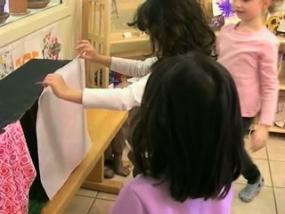Measuring to Size

Measurement is challenging work. It requires children to have knowledge of mathematical concepts, spatial relationships, and measurement tools, and to then coordinate those understandings in order to carry out the physical measurement. This video clip shows three five-year old girls, Grace, Maya, and Peyton, working to measure a curtain from paper to hang across the front of their puppet theater.
Estimation and Size Comparison
The children know how to determine if they measured accurately. As the clip begins, notice that Grace uses estimation to confirm their measurement. She says, “Let’s check,” and she holds the length of paper up in front of her as if to compare it to puppet theater box that is resting on a bench, a few feet away. Grace says, “Okay. That is going to be so bigger.” The girls then use a second strategy to check their measurement. They compare the size by holding the paper up to the puppet theater and discover that the length of the paper does not extend across the length of the box.
Point of Origin
Notice that the off camera teacher works to help the children think about what may be the source of their problem by reminding the girls that they measured the length of the puppet theater from one corner to the other. The teacher says, “So, so, originally when you measured it, you measured it from this corner (points, 00:38) all the way to this corner (points, 00:40). However, in order to measure accurately the children also need to understand that they must begin measuring from the same point of origin. The point of origin could be any number (zero, one, five, etc.), but the children must begin at the same number location when measuring both the puppet theater and the length of paper they intend to use as a curtain. Later, the teacher offers the children a more detailed hint (01:13) by saying, “I’d like to remind you that when you did this, you started with the tape measure at number one and you went all the way over and it went to number twenty-eight. When you started with this paper measuring, did you start at number one?” Later on, when the girls measure a new length of paper, notice that Peyton works to apply her developing understanding about the point of origin. She says, “So, the problem was we didn’t start by ones” (02:38) as she works to align the tape measure with the edge of the paper.
Measurement Tools
The children know that certain tools to help them measure and they are beginning to develop an understanding of how to implement these measurement tools. When the children return to the table to measure a new length of paper Peyton focuses her attention on marking the end point of the measurement in order to make the line along which to cut the paper. Notice that Peyton initially picks up the measuring tape, but then sets it aside and instead, retrieves a t-square. Peyton may believe that a rigid tool is better for measuring a flat surface such as paper, and the shape of a t-square resembles a ruler. Although the t-square does not include ruler markings or numbers, Peyton indicates that she is thinking about the number twenty-eight. She holds a pen in her right hand and motions as if to mark the paper as she says, “You had twenty-eight then you would go to…” (02:02). At this point, the teacher reminds the children what tool to use by saying, “I’m confused as to where your measuring tape is” (02:12). Unlike the t-square in the video, a measuring tape or ruler is etched with markings that denote the measurement of distance. Perhaps the children’s knowledge about the features and function of a measuring tool might be extended if the teacher asked the children how they know where to mark twenty-eight. She might say something like, “I’m wondering how you know that spot where you are pointing your pen is twenty-eight. I think it might be ten. Is there some way we can be sure?”
Standard Units of Measurement
Peyton shows her knowledge of numbers as she looks at the measuring tape (03:40) and reads aloud by saying, “It’s twenty – okay (points with tip of pen at numbers on measuring tape as she counts) thirty, forty, fifty, sixty, sixteen, fifteen, nineteen…” But to measure successfully, the children also need to gain an understanding of how to use and interpret the markings on the measuring tape. Recall that when the girls work to ensure their measurement starts at one, Grace says, “Put it to the very end of the gold part,” as she aligns the metal tab of the tape measure with the edge of the paper. In fact, the end of the metal tab would indicate that their measurement starts at zero. Perhaps by asking the girls what the marks on a ruler may mean, the teacher could encourage the children to begin thinking about how same-sized units of measurement are used to determine a particular length; and further, that the length is represented by a number. What strategies would you use with your children to help them better understand that the numbers signify the space covered by all units counted up to that point?
Keywords: Fives, Children-Teacher, Math, Measurement, Rulers, Numbers, Collaboration
Length of Video: 5 minutes 10 seconds
